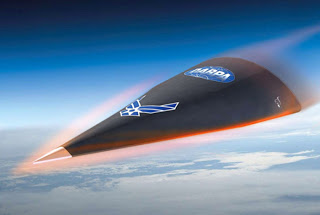Weapon designed for urgent threats
Shaun Waterman
The Washington Times
Defense Department scientists are set to conduct a second test launch next year of the Falcon HTV-2 experimental superweapon after the first flight this year ended when the autopilot deliberately crashed the unmanned glider into the ocean as a safety measure.
The Falcon Hypersonic Test Vehicle is designed to skim the top of the atmosphere just below space, and is a key element of the Pentagon‘s Conventional Prompt Global Strike (CPGS) capability — a program to build non-nuclear strategic weapons that can strike conventionally anywhere in the world in less than an hour.
In a statement last week, the Defense Advanced Research Projects Agency (DARPA) revealed for the first time that the first test flight April 20 ended when the autonomous onboard control system — the computer autopilot flying the futuristic superweapon — “commanded flight termination.”
“When the onboard system detects [undesirable or unsafe flight] behavior, it forces itself into a controlled roll and pitchover to descend directly into the ocean,” DARPA spokesman Eric Mazzacone explained in e-mail to The Washington Times.
The DARPA statement said that an independent engineering review board found that the flight was terminated after the plane began to roll so violently that it “exceeded the available control capability” of the onboard autonomous piloting system.
Specialists say such problems are expected in test flights.
DARPA said the board “reviewed and concurred with” a series of remedial measures proposed for a second test flight next year, but some analysts said the results of the first one raise questions about the way the program has been run.
The $308 million Falcon HTV-2 is a suborbital near-space vehicle launched on a Minotaur rocket, a solid-fuel booster built from a decommissioned ballistic missile. On the very edge of the atmosphere, in a procedure called “clamshell payload fairing release,” the launch missile deploys the plane, which is then supposed to glide above the Earth at more than 13,000 miles per hour — more than 20 times the speed of sound.



Be the first to comment on "Pentagon to test 2nd near-space strike craft"